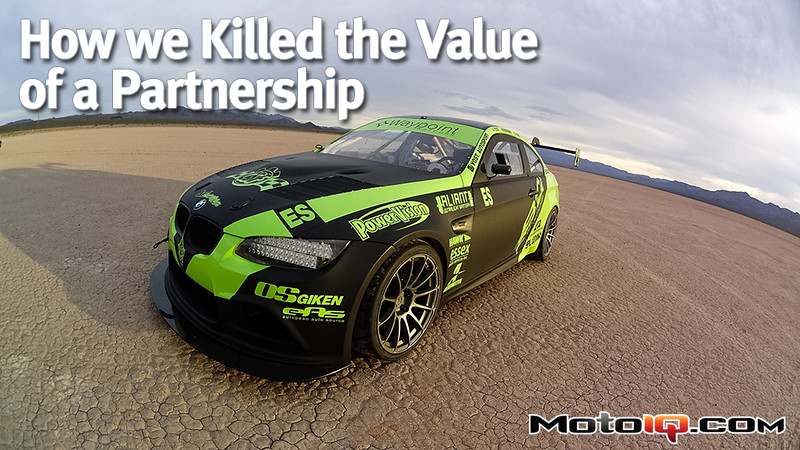,
 Always be a worthy brand ambassador to your partners. If the media asks if you’re available for an interview, photo, etc. the answer is always yes. That’s extra exposure for your partners that they weren’t expecting and it costs you nothing but a few minutes of your time. It’s the little things that will separate you from the rest of the teams they support.
Always be a worthy brand ambassador to your partners. If the media asks if you’re available for an interview, photo, etc. the answer is always yes. That’s extra exposure for your partners that they weren’t expecting and it costs you nothing but a few minutes of your time. It’s the little things that will separate you from the rest of the teams they support.The Internship
Ah the internship; If you represent our company well this year and prove yourself to us, then next year we’ll actually invest in you. Are you sensing a theme here yet? The theme is companies offering up little to no risk on their end in return for high reward which completely devalues the relationship. What if the tables were turned? What if I come to your company and say “hey, I want to start a partnership with you, but first I want to try your product for a year free of charge then if I like it we can work out a deal for next year.” Does that still sound like a good deal to you? Even internships in the real world are only beneficial if the relationship is based on student-teacher roles. Take a traditional job internship for example. Sure the student is working for the company for no money but the value is in the education, there is still a give and take on both sides. Really the only way I can think of where this type of arrangement works in the automotive partnership sense is in the case of a company that has a structure in place to develop and train their future brand representatives.
 Seen here is a Pro Mazda open wheel racer. These cars make up the second rung in Mazda's Road to Indy ladder system.
Seen here is a Pro Mazda open wheel racer. These cars make up the second rung in Mazda's Road to Indy ladder system.The case of Mazda partnering with young race car drivers is the perfect example. Mazda finds drivers at a young age and works out a deal with them to race and compete under the Mazda brand. Mazda starts them out in low level grassroots racing teaching them and molding them into the best race car drivers they can along the way. Eventually the drivers graduate up to the next level and keep on going until they one day finally get to a level where Mazda starts paying them to drive for their top level factory race team. That same mentality just doesn’t apply to products unfortunately. It is a lot of faith to put into a company that they are going to follow through on their word in the end and if even the hint of a better deal comes along they will not hesitate to up and leave to your competitor instead. The real problem here though is subconsciously dooming the relationship from the start. You’re telling that person that you don’t trust them and you don’t see the value of their program even in the slightest form. Unfortunately in today’s society the honor system is no longer widely trusted. These days you have to pay for gas before you pump it.
The Inactive Partner
This is when you reach a deal with a partner and then that’s the last you ever hear from them. It’s usually the same companies that like to complain about that same thing being done to them. They never acknowledge the partnership publicly, and half the time the rest of the employees at that company have no idea who you are or that you’re in a partnership with them. Companies still LOVE to do this though and I can’t for the life of me figure out why. Perhaps it’s because you’re only one of 200 teams they support. Perhaps they feel that their job is done after they deliver the product and the rest is entirely up to you. Either way the company is the one that gets the worst end of this kind of deal and they do it to themselves. If you’re not actively involved with the people you partner with you simply cannot get the most from the relationship. Not only that but you are negatively affecting all of the other partners that team has because the program suffers as a whole. It could be something as simple as posting pictures and updates of your teams on your social media. Picture a program with 10 partners that all have Instagram accounts, collectively the total number of followers for all 10 of those accounts is over 3 million people. If all 10 companies actively share photos of the same car they all partner on together then your logo is being seen on 10 different Instagram accounts to over 3 million people. That’s a lot of eyeballs for something that doesn’t cost anything but a minute of your time to do your part. Now let’s say 7 of those 10 companies don’t ever do that at all because they’re too big to care about your grassroots programs. The remaining 3 partners are small and are investing as much as their little businesses can into this partnership but their collective followers only total 15,000. They post once a week about this car, but instead of 3 million people seeing your car every week, now only 15,000 do.

Or we can take the involvement scenario to a bigger level, one that I personally tell all of our partners on our endurance race team prior to our biggest race of the year, the 25 Hours of Thunderhill. To be able to say that your products completed 25 hours of straight racing is a big feather in the cap of many companies. Many companies find huge value in that kind of credibility and validation for their product. It is very important that we do everything in our power to have the best chance of finishing that race. We (team Principle Jordan Yost, and I) harp on our partners about the importance of making sure we have spares of their parts. Not because we want to sell them afterward, but because we don’t want their part to be the reason we don’t finish the race. We don’t want their part to be the reason that all of our other partners aren’t able to claim that their product finished that race. Even if you have 100% confidence in your product something completely out of your control can cause your product to need to be replaced. We have the utmost confidence that every product we put on our race car will not break during that race on its own, but that’s not to say we won’t get hit by another car and need to replace an entire corner. It’s no fault of your product but if we don’t have a spare it ends our race. We find it amusing that many times we are the ones that have to convince our partners of this the first time they partner with us. The bottom line is that being actively involved with those you partner with is the only way to guarantee that they have everything they need to represent your company in the best light possible. Everyone grows as a team, everyone wins as a team, but everyone also fails as a team. You’re not the only one that is negatively affected in this scenario.
Thinking Inside the Box
It seems the larger a company gets the smaller minded they become. Micro-managing is the nail in the coffin for any partnership program. So many companies seem so focused on providing a paper trail of benefit to the types of partnerships in question when the reality is there’s almost never a way to truly value an ROI on paper. I am sure that the person who handles your partnership has to answer to their boss and their boss probably has no involvement with the motorsports side at all but he or she still requires you to provide proof of return. The problem is in the structure of the entire system as it doesn’t necessarily work like that. Some partnerships are set up this way but I think there’s so much more value to motorsports or other like kinds of partnerships outside of direct sales. You hear it time and time again, if I give you one item, I need you to prove that you sold three in return. That is so narrow minded and it’s once again setting everyone up for failure. How do you track the guy that fell in love with your product because of our car, but has to save for a year before he can buy it? Who do you give credit to if you’re one of three cars that influence a customer’s purchase? There’s no real way to accurately track it, but that’s not really the point, there’s so much value that partnerships can bring to the table that have nothing to do with hand walking customers to the checkout line. There’s value in R&D, there’s value in brand awareness, there’s value in brand reputation, there’s value in team building, there’s value in so many ways outside of direct sales that many companies give up on tremendous opportunities and relationships because they are failing to see the bigger picture.




